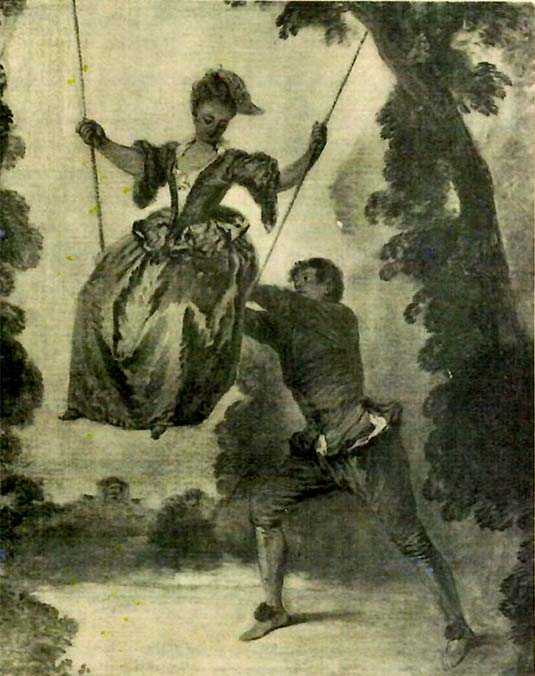
- Home Page
- Accepted
Paintings & Copies - Doubtful
Attributions - Doubtful Textual References
- Alternative
Titles - Collectors &
Museums - Bibliography
- Search Abecedario
- Watteau &
His Circle
L’Escarpolette (copy 1)
Entered February 2022
Whereabouts unknown
Oil on panel
57 x 42 cm
PROVENANCE
Paris and San Donato (near Florence), collection of Anatoly Demidov, first Prince of San Donato (1813-1870; industrialist and diplomat). His collection passed to his nephew, Pavel Pavlovitch Demidov.
San Donato (near Florence), collection of Pavel Pavlovitch Demidov, second Prince of San Donato (1839-1885). His sale, Florence, Palace of San Donato, March 15, 1880, lot 1447: “WATTEAU (JEAN-ANTOINE) . . . L’Escarpolette. Un jeune homme met en movement l’escarpolette sur la quelle est assise une jeune femme. Une des dernièrs oeuvres du maître, peinte l’année qui précéda sa mort. Morceau enlevé de verve, d’esprit et d’une charmante tonalité.Toile. Haut., 0 m. 54 cent.; larg., 0 m. 44 cent.”
Paris, Collection Charles Porgès. His sale, Paris, Hôtel Drouot, March 22, 1907, cat. 12: “WATTEAU (ANTOINE) . . . L’Escarpolette. Dans un parc, une jeune femme est assise sur une escarpolette, tenant de ses deux mains les cordes qui la soutiennent. Un jeune homme lui donne l’élan. Tête nue, les bras tendus, le torse pliant dans un gracieux effort, il est vêtu à la façon des Mezzetins, d’une veste ajustée et d’une culotte courte serrées sur des bas blancs. Des coques de ruban rouge ornent ses souliers. Son aimable compagne a les yeux baissés sur lui, les cheveux relevées, bouffant sous un petit chapeau de paille, la poitrine découverte et les bras demi-nus; elle porte un corsage de soie gris à larges manches et aux basques relevées sur une simple jupe de satin rose.
A droite, un arbre au feuillage autumnal. A gauches, un dieu Terme entouré d’une légère frondaison. Ver le fond, un course d’eau. Au bas, une construction couverte de toiles rouges, sous un ciel éclairé par le soleil couchant. Oeuvre rare, admirable de verve et d’esprit, d’une tonalité claire et lumineuse.Toile. Haut., 56 cent., larg., 46 cm. Ancienne collection du Palais de San Donato, no 1447.” Sold for 44,000 francs to de Bienelle [name not fully legible].Paris, collection of André Chevrillon. Chevrillon’s ownership is cited by Réau, but without documentation. This seems plausible since he owned other works from the Porgès collection such as a head painted by Greuze (sold London, Christie’s, May 14, 2009, lot 40). Perhaps Bienville acted as his agent at the Porgès sale. Adhémar mistranscribed the owner’s name as “Chevrillard,” an error repeated by Macchia and Montagni.
Paris, Galerie André Weil. This provenance, cited by Adhémar, is otherwise undocumented.
Paris, Galerie Wildenstein.
Paris, collection of Jules Strauss (1861-1943; banker). His sale, Paris, Palais Galliera, March 7, 1961, lot 29: “WATTEAU (École de Jean-Antoine) . . . La balançoire. Une jeune femme en corsage rose et jupe jaune, coiffée d’un chapeau de paille légèrement incliné sur ses cheveux blonds, est assise sur une escarpolette que pousse un jeune homme debout à droite. Une perspective de parc s’ouvre entre des frondaisons automnales. Papier maroufflé sur bois. Haut., 0m57; Larg., 0m42. Cadre en bois sculpté. Cf. Watteau par Mme Hélène ADHÉMAR (Paris, 1950) no 60 du catalogue avec les indications suivantes: «Non gravé. Donné par Strauss à Watteau: c’est une variante de «l’Escarpolette». Collection Wildenstein, collection Strauss». (Voir la reproduction, pl. XIII.)”
SELECT BIBLIOGRAPHY
Dacier, Vuaflart, and Hérold, Jean de Julienne et les graveurs (1921-29), 1: under cat. 67.
Réau, “Watteau” (1928), under cat. 264.
Adhémar, Watteau (1950) cat. 60.
Macchia and Montagni, L’opera completa di Watteau (1968), cat. 36.
REMARKS
Réau and Macchia and Montagni rightly considered this picture as one of several replicas of the Helsinki painting but they did not recognize that it was the same as the painting that had been in the San Donato collection. Adhémar made the same mistake but she also listed this version as the original from Watteau’s hand. Her position is not tenable, especially because the Helsinki picture is closer to the Crépy engraving and includes many of the elements from its original conception as an arabesque: most notably the four term statues supporting the trellis at top. Except for the vestigial remains of one term at the far left, none of that structure is present in this version. More likely, the ex-Demidov painting was based on the Helsinki painting, but only after it had been cut down to its present state. The copyist eliminated the landscape and sky above the young couple, and also reduced the foliage at both sides—focusing all his efforts on the figures.
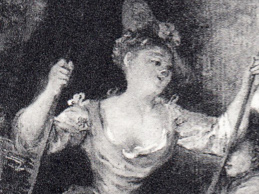
Unknown French artist after Watteau, L’Escarpolette (detail).
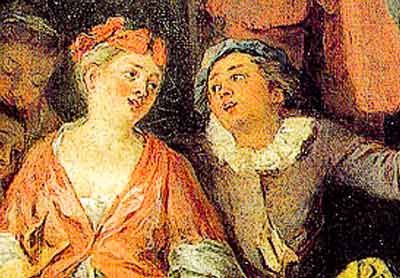
Nicolas Lancret, Concert dans un parc (detail), oil on canvas. Whereabouts unknown.
It is surprising that Adhémar retained this picture as an autograph work by Watteau. One need only consider the woman’s face to measure the gulf that separates this painting from Watteau’s established works. Her head is too large, her short nose has flared nostrils, her parted lips and gently abandoned mood are far removed from Watteau’s more evasive, inward expression. Instead, the stylistic parallels are perhaps closer to Lancret’s early works, an aspect of his career that only now is coming to light. That Lancret would have followed a Watteau invention so closely is surprising, yet his Conversation galante in the Wallace Collection, the painting he may have submitted to the Académie royale in 1718, contains a paraphrase of Watteau’s Voulez-vous triompher des belles? Ultimately, though, we need to see the painting firsthand. It has not been shown publicly for more than a half century and all we have are very dark photographs to guide us.
L’Escarpolette (copy 2)
Entered February 2022

Whereabouts unknown
Medium unknown
Measurements unknown
PROVENANCE
Paris (?), collection Cornudet.
SELECT BIBLIOGRAPHY
Réau, “Watteau” (1928), under cat. 264.
REMARKS
Réau considered this version of L'Escarpolette to be one of several replicas of the Helsinki painting. No information regarding the picture or the owner has been found.
L’Escarpolette (copy 3)
Entered February 2022
Whereabouts unknown
Oil on canvas
150.2 x 68.9 cm
ALTERNATIVE TITLES
The Swing
PROVENANCE
Paris, Galerie Pardo, by 1965; sold to Mrs. Elizabeth Stafford in 1972
Paris and New York, collection of Elizabeth Stafford (1920-2018). Her sale, New York, Christie’s, November 1, 2018, lot 1235: "FRENCH SCHOOL, 18TH CENTURY, The swing; The kiss returned; and Lovers with a mirror in a landscape. oil on canvas / 59⅛ x 27⅛ (150.2 x 68.9 cm.) / a set of three (3) / $20,000-30,000 / PROVENANCE: / with Galerie Pardo, by 1965, where acquired by the present owner in 1972.
The central figures in these decorative panels derive from prints after paintings by Jean-Antoine Watteau, Jean-Baptiste Joseph Pater and Nicolas Lancret. The Swing is based upon Louis Crépy’s engraving in the Recueil Jullienne (1731) of Watteau’s L’Escarpolette (Simebrychoff Art Museum, Helsinki); The kiss returned reproduces the central pair of figures in Pierre Filoeul’s engraving after Pater’s Le baiser rendu (Portland Art Museum, Portland); and Lovers with a mirror in a landscape reprises two of the figures in Nicolas de Larmessin’s engraving after Lancret’s Youth from his series of The Four Ages of Man (The National Gallery, London)."
REMARKS
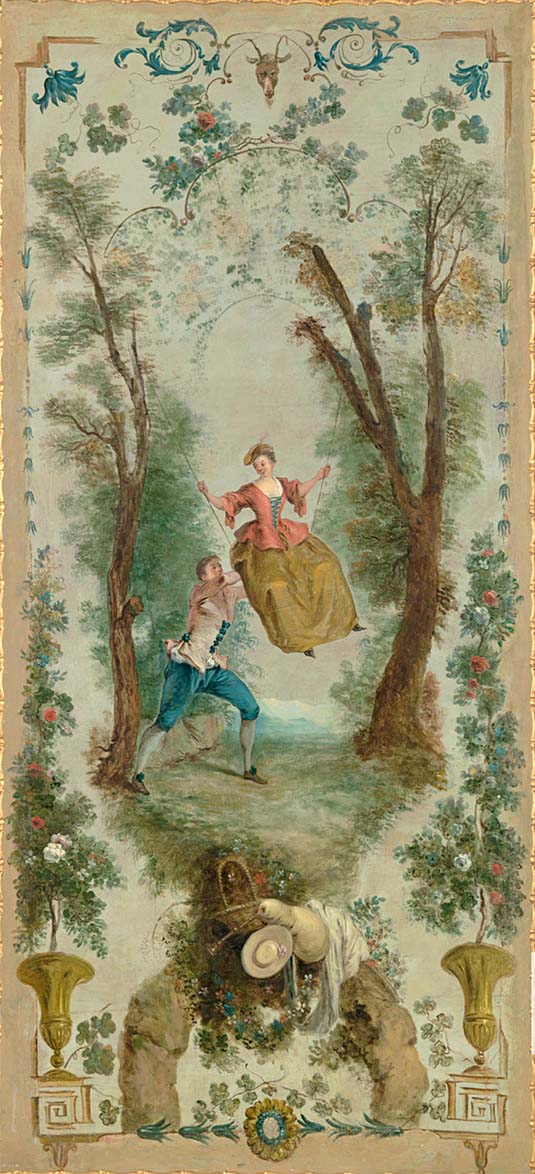
Unknown French artist after Louis Crépy, L’Escarpolette.
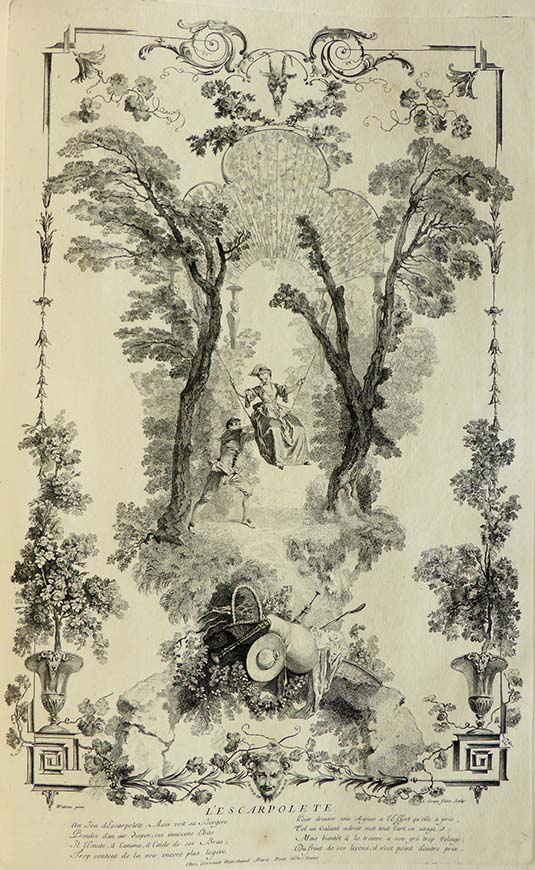
Louis Crépy after Watteau, L’Escarpolette, engraving.
As was noted when the three arabesques came up for sale in 2018, they were based on three engravings of compositions by Watteau, Pater, and Lancret. They bear the hallmarks of a commercial copyist in that they were based on compositions by three different painters and their sources were reproductive engravings rather than the original pictures. But was that copyist actually of the eighteenth century, as the sale catalogue claimed, or could he have worked substantially later? While the copyist closely followed the engraving, he also took considerable liberties: among other things, he omitted Watteau’s elaborate trellis, he introduced a rustic stone arch at the bottom, and replaced the satyr mask at the bottom with an oval medallion.
Click here for L'Escarpolette
